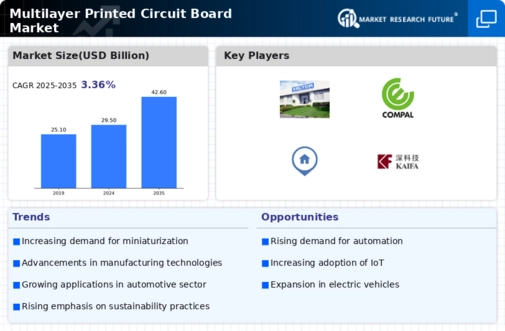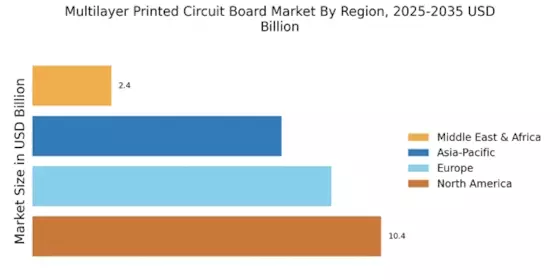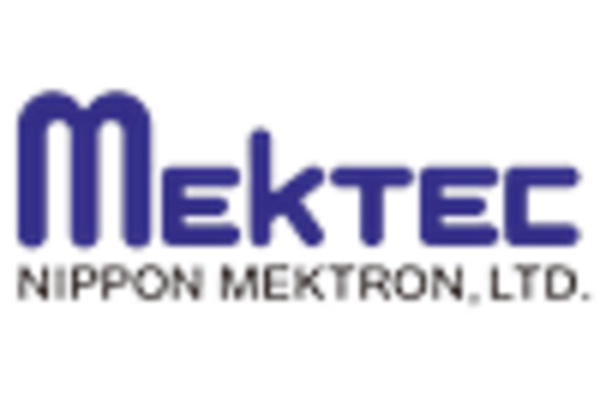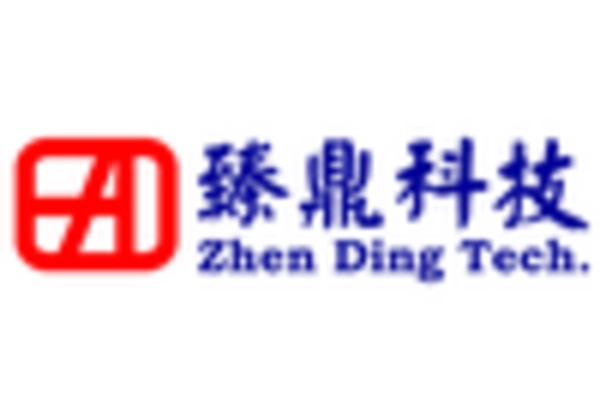Emergence of IoT Devices
The Internet of Things (IoT) is reshaping various industries, leading to an increased demand for multilayer printed circuit boards. The Multilayer Printed Circuit Board Market is likely to see growth as IoT devices proliferate across sectors such as healthcare, agriculture, and smart homes. These devices require compact and efficient circuit boards to support their functionalities. As the number of connected devices is projected to reach billions by 2025, manufacturers may need to adapt their production strategies to cater to the specific requirements of IoT applications, thereby driving innovation and growth in the multilayer printed circuit board market.
Growth in Automotive Electronics
The automotive sector is undergoing a transformation, with the integration of advanced electronics in vehicles. The Multilayer Printed Circuit Board Market is poised to benefit from this trend, as modern vehicles increasingly rely on sophisticated electronic systems for navigation, safety, and entertainment. Reports indicate that the automotive electronics market is expected to grow at a compound annual growth rate of around 7% through 2025. This growth is likely to drive demand for multilayer printed circuit boards, which are essential for the compact and efficient design of automotive electronic components, thus enhancing the overall performance and functionality of vehicles.
Rising Demand for Consumer Electronics
The Multilayer Printed Circuit Board Market is experiencing a surge in demand driven by the increasing consumption of consumer electronics. As devices such as smartphones, tablets, and wearables become ubiquitous, the need for advanced circuit boards that can support complex functionalities is paramount. In 2025, the consumer electronics sector is projected to account for a substantial share of the market, with estimates suggesting a growth rate of approximately 6% annually. This trend indicates that manufacturers are likely to invest heavily in multilayer printed circuit boards to meet the evolving requirements of high-performance electronics, thereby propelling the market forward.
Advancements in Manufacturing Technologies
Technological advancements in manufacturing processes are significantly influencing the Multilayer Printed Circuit Board Market. Innovations such as automated production lines and advanced materials are enhancing the efficiency and quality of circuit board manufacturing. These advancements not only reduce production costs but also enable the creation of more complex and reliable multilayer boards. As manufacturers adopt these new technologies, they are likely to improve their competitive edge in the market. The ongoing evolution in manufacturing capabilities is expected to support the growing demand for multilayer printed circuit boards, particularly in high-tech applications.
Expansion of Telecommunications Infrastructure
The expansion of telecommunications infrastructure is a critical driver for the Multilayer Printed Circuit Board Market. With the rollout of 5G technology, there is a heightened need for advanced circuit boards that can handle increased data transmission speeds and connectivity. The telecommunications sector is projected to invest significantly in upgrading its infrastructure, which includes the deployment of multilayer printed circuit boards in base stations and network equipment. This investment is expected to create substantial opportunities for manufacturers, as the demand for high-frequency and high-density circuit boards rises in tandem with the growth of 5G networks.

















Leave a Comment